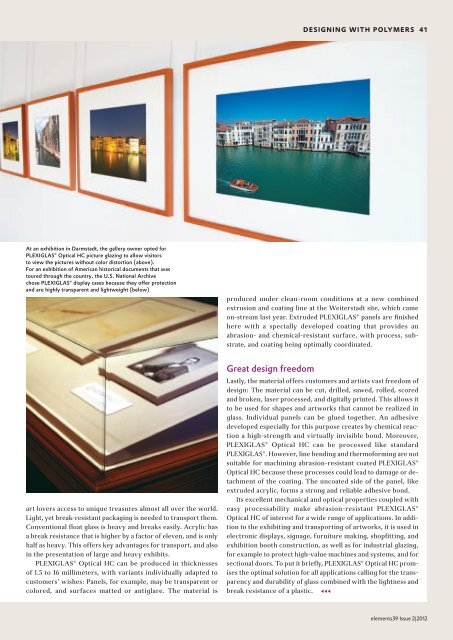Download - Evonik Industries
Download - Evonik Industries
Download - Evonik Industries
Create successful ePaper yourself
Turn your PDF publications into a flip-book with our unique Google optimized e-Paper software.
At an exhibition in Darmstadt, the gallery owner opted for<br />
PLeXIGLAS® Optical HC picture glazing to allow visitors<br />
to view the pictures without color distortion (above).<br />
For an exhibition of American historical documents that was<br />
toured through the country, the U.S. national Archive<br />
chose PLeXIGLAS® display cases because they offer protection<br />
and are highly transparent and lightweight (below)<br />
art lovers access to unique treasures almost all over the world.<br />
Light, yet break-resistant packaging is needed to transport them.<br />
Conventional float glass is heavy and breaks easily. Acrylic has<br />
a break resistance that is higher by a factor of eleven, and is only<br />
half as heavy. This offers key advantages for transport, and also<br />
in the presentation of large and heavy exhibits.<br />
PLEXIGLAS® Optical HC can be produced in thicknesses<br />
of 1.5 to 16 millimeters, with variants individually adapted to<br />
customers’ wishes: Panels, for example, may be transparent or<br />
colored, and surfaces matted or antiglare. The material is<br />
desIGnInG WItH PoLYMeRs<br />
produced under clean-room conditions at a new combined<br />
extrusion and coating line at the Weiterstadt site, which came<br />
on-stream last year. Extruded PLEXIGLAS® panels are finished<br />
here with a specially developed coating that provides an<br />
abrasion- and chemical-resistant surface, with process, substrate,<br />
and coating being optimally coordinated.<br />
Great design freedom<br />
Lastly, the material offers customers and artists vast freedom of<br />
design: The material can be cut, drilled, sawed, rolled, scored<br />
and broken, laser processed, and digitally printed. This allows it<br />
to be used for shapes and artworks that cannot be realized in<br />
glass. Individual panels can be glued together. An adhesive<br />
developed especially for this purpose creates by chemical reaction<br />
a high-strength and virtually invisible bond. Moreover,<br />
PLEXIGLAS® Optical HC can be processed like standard<br />
PLEXIGLAS®. However, line bending and thermoforming are not<br />
suitable for machining abrasion-resistant coated PLEXIGLAS®<br />
Optical HC because these processes could lead to damage or detachment<br />
of the coating. The uncoated side of the panel, like<br />
extruded acrylic, forms a strong and reliable adhesive bond.<br />
Its excellent mechanical and optical properties coupled with<br />
easy processability make abrasion-resistant PLEXIGLAS®<br />
Optical HC of interest for a wide range of applications. In addition<br />
to the exhibiting and transporting of artworks, it is used in<br />
electronic displays, signage, furniture making, shopfitting, and<br />
exhibition booth construction, as well as for industrial glazing,<br />
for example to protect high-value machines and systems, and for<br />
sectional doors. To put it briefly, PLEXIGLAS® Optical HC promises<br />
the optimal solution for all applications calling for the transparency<br />
and durability of glass combined with the lightness and<br />
break resistance of a plastic. 777<br />
41<br />
elements39 Issue 2|2012
















